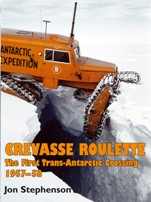Crevasse Roulette: The First Trans-Antarctic Crossing 1957-8
CREVASSE ROULETTE: THE FIRST TRANS-ANTARCTIC CROSSING 1957-8
JON STEPHENSON Published by: Rosenberg, New South Wales, PO Box 6125
Publication date: 2009 ISBN: 9781877058660 (Hbk) List price: £22.50 192pp E: [email protected]

This unusual book is not by one of the expedition leaders (Fuchs and Hillary), but by the youngest and most inexperienced supporting participant, 50 years after the event. The TAE has been called an ‘anachronism’, but it was scientifically valuable, providing samples of three unexplored ranges, the Theron Mountains, Shackleton Range and Whichaway Nunataks.
The author writes well and there only a few minor slips. He is self-deprecating and humorous about his scrapes. The near-disasters experienced by the Sno-Cats in crevasses are horrifyingly illustrated (the illustrations are spectacular). Fuchs appointed a very experienced team (except for Stephenson) including pilots, wireless operators and mechanics, and men of remarkable resource like Blaiklock who, with Stephenson, led the way probing for crevasses with dog teams. Jon carried out valuable geo-reconnaissance and sampling in the three ranges, and wintered at South Ice with three companions.
Fuchs needed to bring in Hillary to get New Zealand on side. Hillary could never be a deputy, but nevertheless carried out his support role from McMurdo excellently (though not apparently always popular with his team!). His media-highlighted dash to the pole rankled with Fuchs’ team, but it is difficult to see how he could stay weeks at Depot D700 after Fuchs was delayed. The two were highly incompatible; Fuchs with early 1930s experience in five rather amateur Cambridge expeditions to the Rift Valley Lakes, and later professional experience, running the TAE as an ‘informal ship’, ready to change his plans as required whereas Hillary was much more rigid.
Stephenson brings out well the contrast between the formal US set-up run by naval officers (like Scott’s) and the informal TAE. It is apparent from reading this book that the Shackleton’s Endurance expedition, aimed at a comparable continental crossing, would probably have come to grief had landed, lacking modern mechanical.
This excellent book is difficult to put down. I am proud to have participated in the author’s later expeditions to Ambrym Island.
Reviewed by: Joe McCall